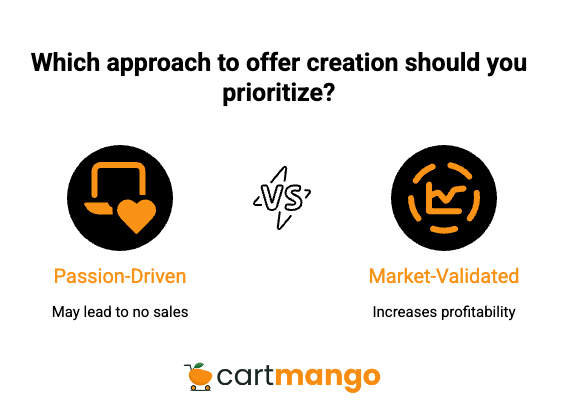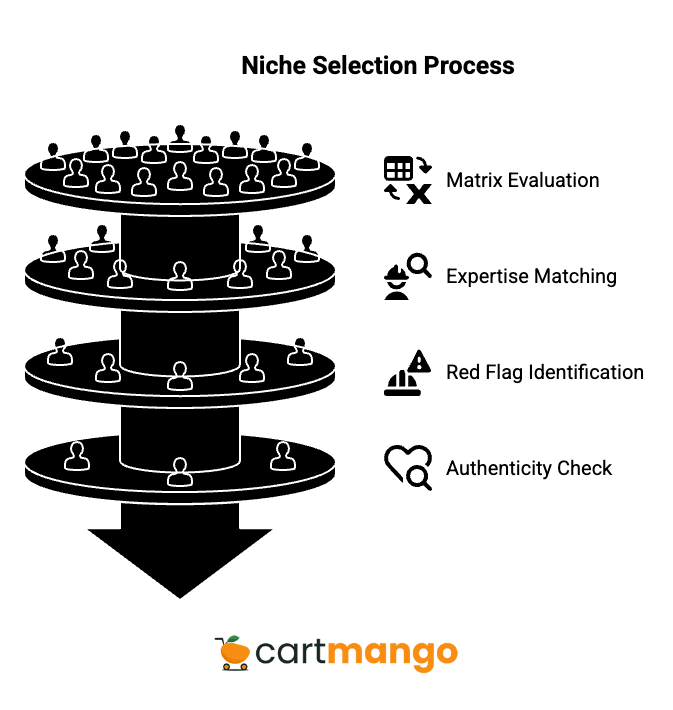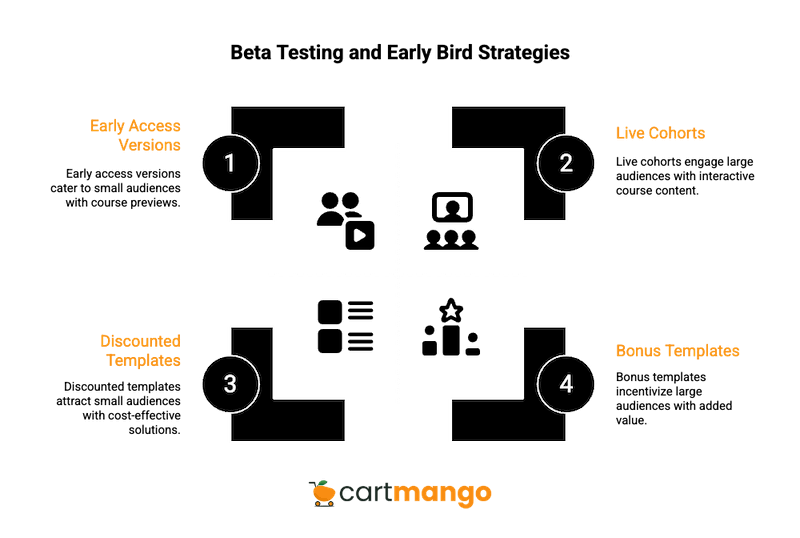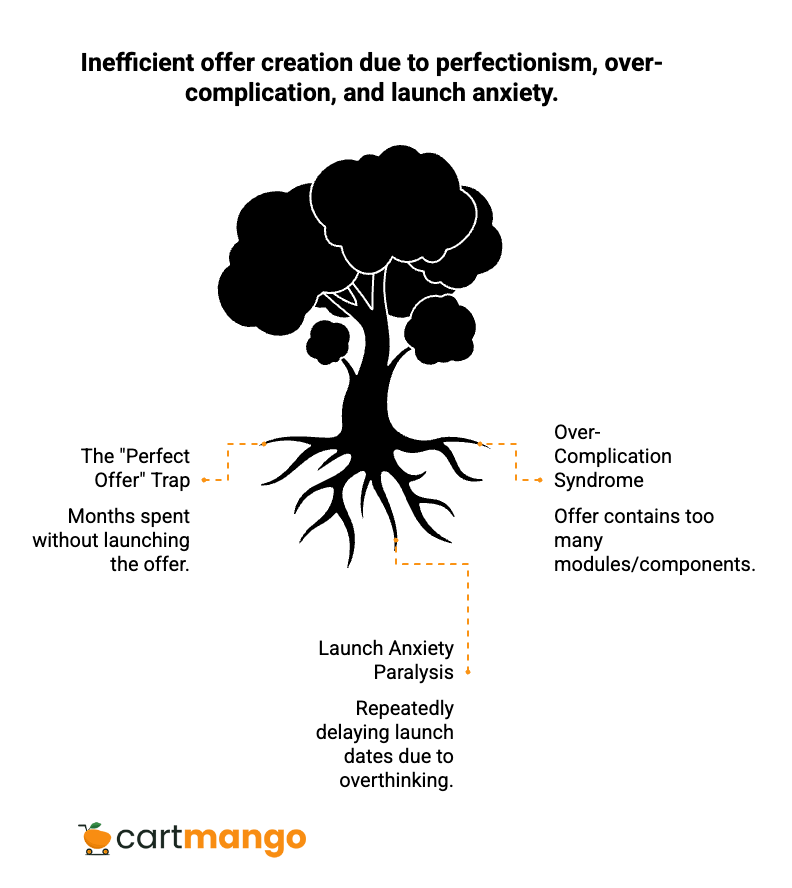You’re staring at your laptop screen at 11 PM again.
Another day spent researching “how to create an offer” without actually creating anything. I’ve been there.
Most offer creation guides tell you to “follow your passion.” That’s terrible advice. Passion without profit leaves you broke and discouraged.
I’m showing you something different. A proven system that successful course creators, coaches, consultants, and digital product sellers actually use.
You’ll choose your profitable niche and launch your first offer in 30 days using real market data.
The 2025 Niche Selection Matrix for Solo Creators
This matrix eliminates the guesswork that keeps entrepreneurs stuck in analysis paralysis. Most people waste 6-12 months trying random niches. You’re going to skip that pain entirely.
| Niche | Best-Selling Offer Types | Unique Positioning Angles | Primary Pain Points | Biggest Objections + Solutions | Content That Converts |
|---|---|---|---|---|---|
AI & Tech for Non-Techies | – AI prompt libraries ($97-297) – “AI in 30 days” courses ($497-997) – Done-for-you automations ($1,997-4,997) | – Industry-specific (AI for therapists) – Tool-specific mastery (ChatGPT for lawyers) – “Human + AI” hybrid approaches | – Overwhelm with new tools – Fear of being replaced – Technical complexity anxiety | Objection: “Too complicated” Solution: Start with one simple tool | – Before/after AI implementations – “5-minute AI wins” content – Fear-busting case studies |
Health & Wellness Coaching | – 90-day transformation ($997-2,997) – Habit tracker systems ($197-497) – Group coaching circles ($297/month) | – Life-stage specific (menopause wellness) – Profession-focused (wellness for nurses) – Cultural / dietary approaches | – Chronic fatigue/burnout – Overwhelm with conflicting advice – Lack of sustainable systems | Objection: “I’ve tried everything” Solution: Focus on small, sustainable wins | – Personal transformation stories – “Day in the life” content – Myth-busting posts |
Digital Marketing for Creators | – Platform-specific courses ($297-1,997) – Content templates ($97-297) – 1:1 audit services ($497-1,497) | – Platform specialization (TikTok for B2B) | – Algorithm confusion – Content creation overwhelm – Inconsistent results | Objection: “Algorithms always change” Solution: Focus on timeless principles | – Behind-the-scenes growth – Algorithm update explanations – Client result case studies |
Personal Finance Freedom | – Debt payoff programs ($497-1,997) – Investment starter kits ($297-997) – Financial planning templates ($97-297) | – Life situation specific (finance for freelancers) – Income-level focused approaches – Emotional money healing | – Financial anxiety/shame – Debt overwhelm – Investment paralysis | Objection: “I don’t make enough” Solution: Start with small amount strategies | – Debt payoff success stories – “Lazy” investment strategies – Money mindset breakthroughs |
Relationship & Communication | – Dating confidence courses ($397-1,497) – Conflict resolution guides ($197-697) -Communication workshops ($497-2,497) | – Demographic specific (dating for introverts) – Situation-focused (couples + careers) – Cultural sensitivity approaches | – Communication breakdown – Loneliness / isolation – Conflict avoidance | Objection: “My situation is unique” Solution: Address common patterns | – Real conversation examples – Relationship transformation stories – Communication scripts/templates |
Career Transition & Freelancing | – Career pivot roadmaps ($697-2,997) – Freelance startup kits ($297-997) – Interview mastery courses ($197-697) | – Industry-specific transitions – Age-focused approaches (40+ career change) – Side-hustle to full-time paths | – Career stagnation – Income uncertainty fear – Skill relevance anxiety | Objection: “Too risky to leave my job” Solution: Transition planning with safety nets | – Career transformation timelines – Income replacement strategies – Skills audit frameworks |
Business Building for Solopreneurs | – Launch programs ($1,997-9,997) – Systems templates ($497-1,497) – Scaling strategies ($2,997-7,997) | – Business model specific – Revenue stage focused – Industry vertical expertise | – Overwhelm with options – Inconsistent revenue – System gaps | Objection: “I need more experience first” Solution: Start where you are frameworks | – Revenue growth case studies – Behind-the-scenes business building – System breakdowns |
Mindset & Peak Performance | – Confidence building ($397-1,997) – Productivity systems ($297-997) – Goal achievement programs ($697-3,997) | – Achievement-focused (athletes, executives) – Challenge-specific (public speaking) – Identity-based change | – Self-doubt/imposter syndrome – Procrastination patterns – Goal achievement failure | Objection: “Mindset work is fluffy” Solution: Focus on measurable outcomes | – Mindset shift before/afters – Daily routine breakdowns – Achievement milestone content |
Creative Skills & Monetization | – Skill-building courses ($197-997) – Monetization strategies ($297-1,497) – Creative challenge programs ($97-497) | – Monetization angle emphasis – Specific medium focus – Beginner-friendly approaches | – Creative blocks – Monetization confusion – Skill plateau frustration | Objection: “I’m not good enough yet” Solution: Progress over perfection messaging | – Student work showcases – Monetization success stories – Step-by-step tutorials |
Executive & Leadership Development | – Leadership intensives ($4,997-15,000) – Team building systems ($2,997-7,997) – Executive coaching ($5,000-20,000) | – Company size specific – Industry vertical expertise – Remote leadership focus | – Leadership overwhelm – Team performance gaps – Decision-making paralysis | Objection: “We can handle this internally” Solution: ROI and time-saving focus | – Leadership transformation case studies – Team performance metrics – Decision-making frameworks |
How to Use This Matrix
Column 1 helps you choose your market based on your expertise and genuine interest. Column 2 shows what’s currently selling with realistic pricing data. Column 3 gives you unique angles to stand out from competitors.
Column 4 reveals exactly what problems your customers face daily. Column 5 prepares you for the biggest sales obstacles before they derail you. Column 6 shows content that actually converts browsers into buyers.
Rate each niche from 1-10 based on your comfort with the offer types. Match your existing knowledge with the pain points column. Choose positioning angles you can authentically deliver.
“Follow Your Passion” Sucks

“Follow your passion” often leads to 0 sales.
The difference between offer creation and profitable offer creation is market validation. Lean Startup methodology proves that successful entrepreneurs validate demand before building products. They test, measure, adjust.
Generic advice ignores market realities. Niche-specific positioning beats broad approaches every time.
The matrix above eliminates months of costly trial and error. You’re starting with proven niches instead of gambling on random ideas. The competitive advantage comes from objection-ready strategies.
When you know the biggest objections upfront, you can address them in your marketing. Your competitors are still figuring out why people don’t buy.
You already have the answers.
Your 30-Day Implementation Roadmap
Week | Days | Key Tasks | Success Metrics |
|---|---|---|---|
Week 1: Strategic Niche Selection | Days 1-2 | – Score each niche using matrix – Match expertise with pain points – Identify red flags for poor niche fit | Confidence score 8+ for chosen niche |
Days 3-4 | – Quick validation using “Content That Converts” – Social listening for pain points – Test content engagement in target groups | 10+ engaged responses to test content | |
Days 5-7 | – Apply unique positioning angles – Price validation research – Build unique value proposition | UVP that clearly explains your difference | |
Week 2: Minimum Viable Offer Creation | Days 8-10 | – Choose offer format from matrix – Apply minimum viable principle – Avoid over-complication traps | Simple offer description in 2 sentences |
Days 11-12 | – Transform pain points into modules – Apply 80/20 content rule – Create structure templates | Clear learning path for customers | |
Days 13-14 | – Integrate objection handling – Apply pricing psychology – Create guarantee structure | Offer that addresses top 3 objections | |
Week 3: Content Creation & Setup | Days 15-17 | – Select essential platforms only – Set up basic tech stack – Create setup checklist | Functional payment and delivery system |
Days 18-19 | – Create content using proven formats – Use batch creation methods – Focus on trust-building content | Minimum viable content completed | |
Days 20-21 | – Set up beta testing framework – Create feedback systems – Plan early bird strategies | 5+ beta testers confirmed | |
Week 4: Launch & Optimization | Days 22-24 | – Execute soft launch strategy – Use existing network – Handle launch logistics | 3-5 initial sales completed |
Days 25-30 | – Analyze first month results honestly
| – Clear understanding of performance – One actionable improvement identified |
Week 1: Strategic Niche Selection
Day 1-2: Matrix-Based Niche Evaluation

Use the systematic assessment method from the matrix above. I recommend creating a simple spreadsheet with your scores for each niche. Match your expertise with market demand using the pain points column.
Professional skills assessment tools can help you identify transferable skills you might be overlooking. Red flags include niches where you can’t authentically address the main pain points or objections.
If you’re forcing yourself into a niche because it “sounds profitable,” stop. Your lack of genuine understanding will show in your marketing.
Day 3-4: Market Validation in 48 Hours
Quick validation starts with the “Content That Converts” column from your chosen niche. Create 2-3 pieces of that content type and post them in relevant groups or platforms. Social listening confirms pain points in real conversations.
When should you pivot versus persist?
If you get 0 engagement after testing 5 different pain points, consider a different niche. If you get some engagement but feel uncomfortable with the topic, that’s normal beginner anxiety.
Day 5-7: Competitive Positioning Setup
Apply unique positioning angles from the matrix to differentiate clearly. Most people skip this step and wonder why they can’t compete on anything except price. Pricing validation uses the proven ranges from the matrix as starting points.
Your unique value proposition should pass the “elevator test.” Can you explain your difference in 30 seconds to someone who knows nothing about your niche?
–
Week 2: Minimum Viable Offer Creation
Day 8-10: Offer Format Selection

Choose from proven offer types based on your matrix niche.
The minimum viable offer principle means starting with the simplest version that solves the core problem. You can always add complexity later.
Avoid over-complication traps that delay launches. I’ve seen people spend 6+ months creating “comprehensive” courses that cover everything. But their customers wanted solutions to 1 specific problem.
Shorter, focused courses often outperform longer ones. Your goal is transformation, not information overload.
Day 11-12: Pain Point-Driven Content Outline
Transform matrix pain points into sellable curriculum modules. The 80/20 rule applies here – 20% of your content will drive 80% of the results. Focus on what matters most.
Each module should address one specific pain point from your matrix research. Create templates for consistent structure across modules. Quality beats quantity when it comes to customer satisfaction.
Day 13-14: Objection-Proof Offer Packaging
Integrate objection handling from the matrix into your offer structure.
This isn’t about manipulation – this is about addressing legitimate concerns upfront.
When you price things at odd numbers (like $9.99 instead of $10), our brains trick us into thinking we’re getting a better deal. (Source)
The psychology is pretty simple: $9.99 feels cheaper than $10.00, even though it’s only a penny difference. Our eyes focus on that first number (the 9) and our brain says “Oh, this is in the $9 range, not the $10 range.”
It’s a smart sales trick that works on most of us, even when we know what’s happening.
Guarantee structures reduce buyer risk and increase conversions. Match your guarantee to your niche – fitness might offer 90-day guarantees while business consulting might offer 30-day guarantees.
–
Week 3: Content Creation and Pre-Launch
Day 15-17: High-Converting Content Production
Use “Content That Converts” formats from your chosen niche. Batch creation saves time – film multiple videos in one session or write multiple articles in one sitting.
Content that builds trust addresses skepticism head-on. Share your failures alongside your successes. Show your process, not just your results.
Day 18-19: Pre-Launch Validation Systems

Beta testing frameworks vary by offer type.
Course creators might run live cohorts while template sellers might offer early access versions.
Feedback collection should be structured – ask specific questions about value, clarity, and outcomes.
Early bird strategies work well for solo entrepreneurs with small audiences. Offer discounts or bonuses to first customers in exchange for detailed feedback.
Day 20-21: Launch Preparation
Final technical setup includes testing all payment flows and content delivery systems.
- Build anticipation through behind-the-scenes content.
- Show your creation process.
- Share your nervousness – people connect with vulnerability more than perfection.
You can use CartMango to sell your digital offers. It’s free to use for at least 2025.
Disclaimer: We’re the developers of CartMango.
–
Week 4: Launch and Optimization
Day 22-24: Soft Launch Strategy
Your soft launch should existing, relevant connections. This generates real revenue while working out technical issues in a forgiving environment. Use your existing network strategically – don’t just blast everyone with sales messages.
Launch anxiety is normal. I remember refreshing my sales page every five minutes during my first launch. Have backup plans for technical issues because something will go wrong.
Day 25-30: First Month Results and Simple Next Steps
Analyze your first month results honestly. Look at your sales numbers, customer feedback, and what felt hardest during the process.
Focus on 3 simple questions:
- What worked?
- What didn’t work?
- What would you do differently next time?
Write down your answers. Most people skip this step and repeat the same mistakes in month two.
Simple improvements for next month:
- Fix the biggest customer complaint you received
- Improve the one piece of content that got the most engagement
- Adjust your pricing if you had consistent objections
Your goal isn’t to create another offer yet. Perfect your first offer based on real customer feedback. One profitable offer beats three mediocre ones.
Plan one small test for month two. Maybe it’s a different email subject line or a new piece of content. Keep it simple – you’re still learning what your market wants.
Common Offer Creation Mistakes + Quick Fixes

Common Mistake | Warning Signs | Quick Fix |
|---|---|---|
The “Perfect Offer” Trap | – Spending months without launching – Waiting for 100% certainty | – Set a hard launch deadline (30 days max) – Apply 80/20 rule: launch with 80% complete – Start pre-selling before it’s finished |
Over-Complication Syndrome | – Offer has 10+ modules or components – Customers asking “what exactly do I get?” – High refund rates due to overwhelm | – Strip offer down to core 3-5 outcomes – Create simple one-page summary – Remove anything not essential to main result |
Launch Anxiety Paralysis | – Delaying launch dates repeatedly – Overthinking every detail – Fear of negative feedback | – Schedule soft launch with 5 friends/family – Prepare 3 backup plans for tech issues – Set realistic expectations (aim for 3-5 sales) |
Mental Preparation for Launch Success
Realistic expectations prevent disappointment.
Your first offer definitely won’t make you rich. It will teach you what your market actually wants. “Good enough” launched beats “perfect” never released.
Support systems matter more than perfect products. Connect with other creators going through similar challenges. Share your wins and losses with people who understand the journey.
Proven Frameworks That Validate The Matrix
After seeing those common mistakes, you might worry you’re missing something.
Here’s the truth: successful creating offers requires focus, and our matrix proves this works. The entire process aligns with what top solopreneurs already know.
The offer creation part becomes clearer when you see how profitable businesses apply these principles. You don’t need endless resources to build something people want to pay for.
The Science Behind Targeting 1 Person
Most entrepreneurs search the world for customers instead of going deep with their ideal customer. This wastes effort and energy. When you discover one struggling person’s exact problem, everything changes.
Here’s a concrete example:
Instead of “helping entrepreneurs,” you help “solo consultants who can’t price their services.”
The second approach has higher likelihood of success because it speaks to one specific person who can sense you understand their pain.
Making Your Promise Crystal Clear
The benefit of focus extends to your core promise.
Don’t talk in generalities. Present exactly what transformation you provide. When someone understands your offer solves their specific problem, they’ll pay premium prices without hesitation.
Promote outcomes, not processes.
Your customers don’t want to inspire others or have fun learning – they want results. Speak the truth about what you can deliver.
Using Modern Platforms to Build Authority
YouTube and similar platforms let you demonstrate expertise without huge marketing budgets. Share real work, not just theory. Show your actual process helping real people achieve results.
The goal isn’t entertainment, though that helps retention. The goal is proving you can deliver what you promise. One case study video builds more trust than ten talking head videos.
Scaling Your Offer for Sustainable Growth
Month 2-3 Strategy
Analyze which elements of your offer convert best. Double down on what works before trying new things. Create complementary offers within your chosen niche – if you solve problem A, what’s problem B that naturally follows?
Focus on outcomes rather than features. Build systems that help customers achieve results, not just consume content.
Long-Term Business Development
Optimize your first offer before creating your second. A $1,000/month offer improved to $3,000/month beats having three $1,000/month offers. Build recurring revenue streams through coaching calls, community access, or monthly templates.
Community building starts with your first customers. Create spaces where they can connect with each other. Facilitate success stories and peer learning.
Tech Stack for Solo Creators
You need 3 things:
- A way to collect payment
- A way to deliver content
- A way to communicate with customers
Everything else is optional until you’re making consistent sales.
CartMango helps with the first two (free for at least 2025), while BirdSend helps with the third one.
Disclaimer: We’re the developers of both software.
Don’t spend weeks researching platforms. Pick something simple and launch. You can always migrate later when you have actual customer feedback.
Your Immediate Offer Creation Plan
Choose your niche from the above matrix today.
Don’t spend a week “thinking about it”. That’s procrastination disguised as planning. Your next steps depend on action, not perfection.
Track what you can control: content creation, outreach activities, and conversations.
Start your 30-day countdown now. The best time to plant a tree was 20 years ago. The second best time is today.
Related
- Sellfy vs Payhip: The Recurring Revenue Prison (2026)
- Podia vs Gumroad: The Recurring Revenue Handcuffs (2026)
- SendOwl vs Gumroad: The Recurring Revenue Black Hole (2026)
- Gumroad vs Sellfy: The Vendor Lock-in Cage (2025)
- Gumroad vs Payhip: The Hidden Trap for Creators (2025)
- ThriveCart vs SamCart – The Subscription Hostage Trap (2025)
- 8 ThriveCart Alternatives & The Lifetime Pricing Paradox (2025)
- 8 SamCart alternatives + Subscription hostage (2025)
- The GENTLE Method: Soft marketing for creators
- How Far in Advance Should You Promote a Webinar?
